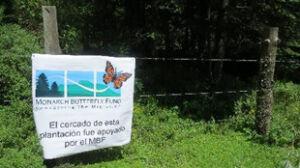
This project is part of a restoration process being undertaken on a 10 hectare area in Sierra Chincua that was illegally logged in 2015. In 2016 MBF funded a fence to prevent cattle grazing around the area and developed a map of what ares should be restored. After that, academics, government agencies, the MBBR staff and neighboring ejidos of the affected site, defined and implemented a restoration plan. The plan included fencing the site, aligning woody debris to retain soil, reforestation (active restoration) and leaving some areas to regenerate naturally (passive restoration). Both restoration processes have been continuously monitored.
As part of the task force that is implementing this plan, Dr. José Arnulfo Blanco García leads the team that is in charge of monitoring the restoration process. The area was fenced and so far natural regeneration by dominant tree species in the adjacent forest is absent. After five years no oyamel, pine or other species have successfully established on the 26 parcels that have been monitored since 2016 in the logged area. Fortunately, the areas that were reforested (active regeneration) in that year have had good survival rates.
Sixty four seed traps were established at different distances and directions to try to find seed dispersal patterns to determine possible reasons why seedlings are absent.

During 2020-2022 the researchers gathered data from the seed traps and their observations suggest that even in years when there are lots of seeds in the forest, the seed dispersal process is seriously compromised in logged areas. To increase sites that foster germination, Dr. García and his team are evaluating the possibility of manually dispersing oyamel seeds and preparing soil accordingly. Another option is to reforest part of the logged area since the natural regeneration process is slow. MBF will continue supporting this important research to seek optimal alternatives for the restoration of the forest. Below is a photo of items found in the seed traps. The environmental newspaper Mongabay (link is in Spanish) recently published an article describing the experiments.





